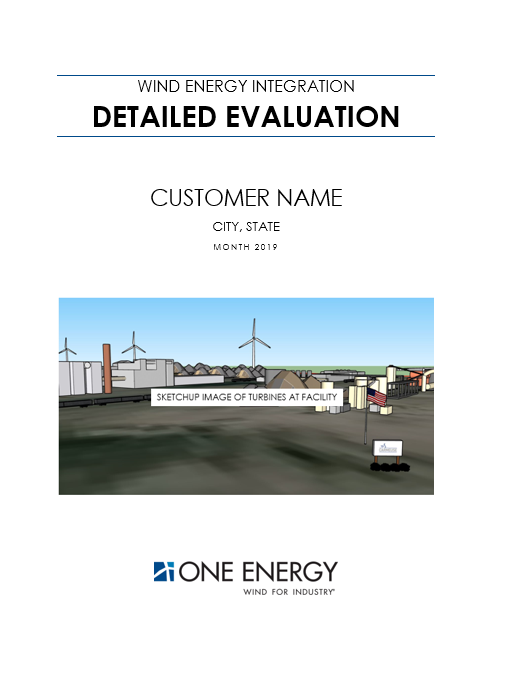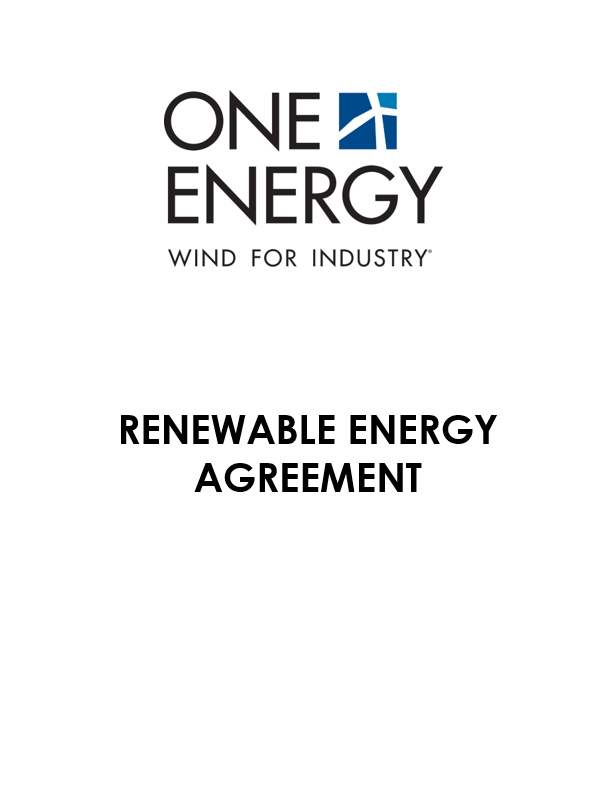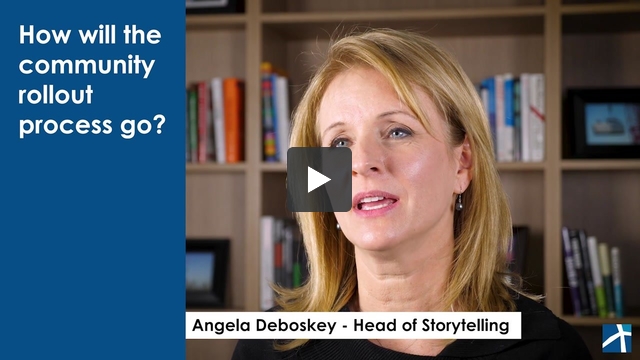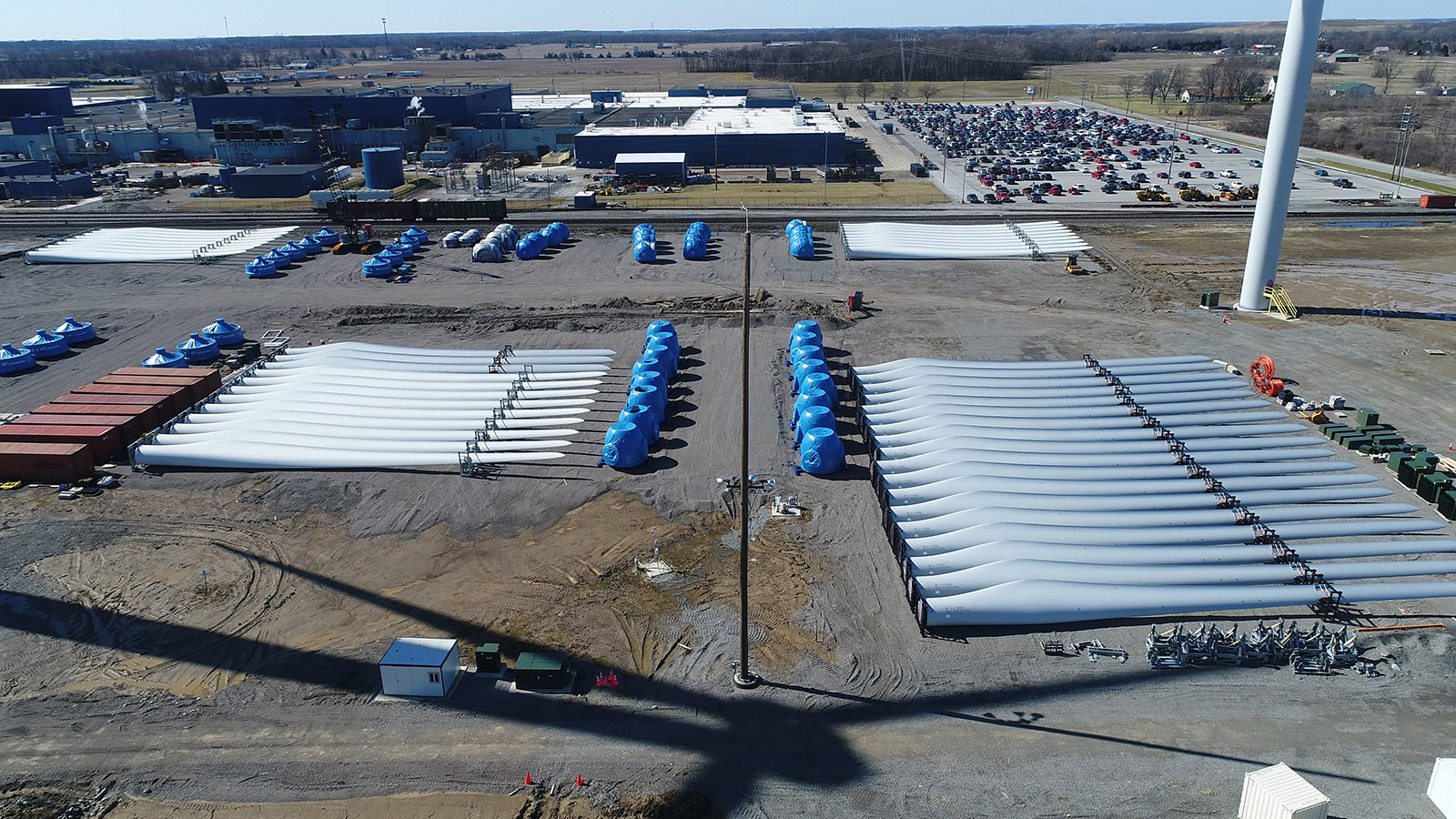A WIND PROJECT: STEP BY STEP

A Wind for Industry project goes through six main stages: screening, feasibility, development, contract execution, project delivery, and project operation.
WHAT’S ON THIS PAGE?
One Energy projects advance through the same general steps as most large wind projects. A key difference is that Wind for Industry projects tend to have a wider range of technical development activities that include a focus on a single customer’s electrical load and local permitting.
A Wind for Industry project goes through six main stages: screening, feasibility, development, contract execution, project delivery, and project operation.
Screening:
To decide if a Wind for Industry project is feasible, our first step is to screen for any issues that might prevent success. During this phase, we are identifying any red flags as early as we can. Filtering out projects that are not viable as soon as possible helps us be efficient with the customer’s time and our own. The main factors we assess when screening a project are:
Since our “fuel” is the wind, a strong wind resource is required for a strong wind project.
1. Airport Proximity: There are restrictions on building tall structures (including wind turbines) near airports. Typically, a project needs to be at least 15,000 feet from a public airport. Regulations vary by airport size and turbine height.
2. Wind Resource:Since our “fuel” is the wind, a strong wind resource is required for a strong wind project. Determining if a potential project site has good or great wind is complicated; however, we can usually tell right away when the wind resource is bad. Projects generally need at least a 25% capacity factor to be viable. One Energy uses national data sets and proprietary screening tools to filter for inadequate wind resources early.
3. Land Availability: Wind turbines are big. To install these large turbines on site, we’ll need a sufficient amount of land near the facility. Wind for Industry projects typically require an 800-foot square area (1.5 acres) of land per turbine that is free of buildings and obstructions. In the screening phase, we are not investigating acquiring the land yet; we are only checking that sufficient land is available.
4. Energy Consumption: Facilities must consume at least 4,000,000 kilowatt hours of electricity per year to be viable for a Wind for Industry project. The more energy a facility consumes, the larger your Wind for Industry project can be. And with economies of scale, larger projects usually have a lower energy cost.
Filtering out projects that are not viable as soon as possible helps us be efficient with the customer’s time and our own.
5. Power Pricing: One Energy has been modeling wind projects for more than a decade, and has developed a substantial predictive data set that helps us indicate the financial performance of a Wind for Industry project. By primarily considering the customer’s current utility rate, along with the wind resource in their area, One Energy can determine if a project will make financial sense for a customer.
Screening a single facility is the first step we take for new customers. If a customer has more than one facility, many times they request a nationwide screening to help determine which of their other locations should consider Wind for Industry.
Screenings are free and can be completed within two weeks; all we need from customers is basic information to fill in the blanks. While we are happy to enter into a non-disclosure agreement if the customer chooses, it’s not required on our end and screening is often conducted without an NDA. One Energy’s policy is to never talk about our customers without their permission, NDA or not.
IE Flowchart
Click to view the general steps One Energy takes to complete an Initial Evaluation report.
We expect a project to mirror the predictions of its Initial Evaluation.
Upon receiving the report, customers have the information they need to decide on taking a project any further.
Feasibility:
In the feasibility step, One Energy produces an Initial Evaluation for potential customers. An Initial Evaluation is a comprehensive but preliminary report to determine the project’s size, siting, energy production, economics, and overall viability. Our in-house Project Planning team investigates the specific details of a project to determine if it is feasible, define its size, and give a recommendation about moving forward.
Our Initial Evaluation reports are expected to be done at 95% confidence and should function as the business case for a company’s internal decision about whether to continue pursuing a Wind for Industry project.
The main report is roughly 50 pages long and considers all aspects of a project, including permitting, land, energy production and consumption, and above-ground and below-ground obstacles.
The Initial Evaluation takes about a month to complete, with no charge to the customer. At this point in the process, One Energy has typically entered into an NDA with a customer. This step is completed without letting the public know a project is being considered. We keep your information and your potential project confidential until it is ready to be announced. We strongly recommend you do the same.
If the Initial Evaluation determines the project is viable, One Energy will also provide a term sheet for a CAPEX or REA project as appropriate based on the customer’s goals. Other firms have charged more than $30,000 for reports comparable to an Initial Evaluation. We don’t think it’s reasonable to charge a customer for a feasibility report.
For REA projects, One Energy will cover the cost of the Detailed Evaluation
This report would typically cost $100,000 – $200,000 from a consultant. We have invested in the process over the last 10 years and have brought the cost down to less than $50,000.
For REA projects, One Energy will cover the cost of the Detailed Evaluation if the customer’s senior management (with approval authority over the project) has reviewed and approved the Initial Evaluation. We do not require letters of intent or any other commitment documents. We’re expecting you to trust us for 20 years, so we trust you when you say you are serious about the project.
For CAPEX projects, the customer pays the cost of the Detailed Evaluation. A quote will be provided in the term sheet with the Initial Evaluation.
All projects are kept confidential during this stage. There are some instances when a limited public disclosure may be required, depending on the specifics of the project. An example of a “limited public disclosure” is an interconnection study with the utility. Even then, One Energy is usually able to keep the project confidential throughout this process, and we always communicate with and get approval from the customer before anything goes public.
When the development step is completed, we are ready to contractually commit to your project.
Contract Execution:
Most companies have never signed a 20-year agreement and most companies have never bought a wind turbine. We know the approval process takes time to work through, as does contract review and execution. Typically, C-suite executives must approve contracts of this length.
We like to see the Contract Execution process run concurrently with the Development process, so we are being as efficient as possible with everyone’s time.
The only document that needs to be signed is the Renewable Energy Agreement. In some cases, the REA contains leases and easements as exhibits. You can review our standard REA now or at any time, and we are happy to answer any questions you have about it. In general, we hold to that form very strictly. We are happy to work through the document with your legal and accounting teams. We pride ourselves on the fact that our REA has been accepted by so many different organizations. We think that means we have written a fair contract. We will be the most reasonable group you have ever worked with.
Corporate Value #7: Charge a Fair Price and Get Paid for Our Work.
The contract execution stage often involves a conversation with internal and external accountants and auditors, to ensure the project is not treated as a lease under GAAP. Our REA has been reviewed by a number of external auditors, including the Big 4, to conclude in each case it is not a lease under GAAP.
If a customer is choosing the CAPEX option for their Wind for Industry project, then the contract execution stage will involve a DEPCO Agreement instead of an REA. This agreement confirms the development, engineering, procurement, construction, and operation (DEPCO) conditions of CAPEX projects.
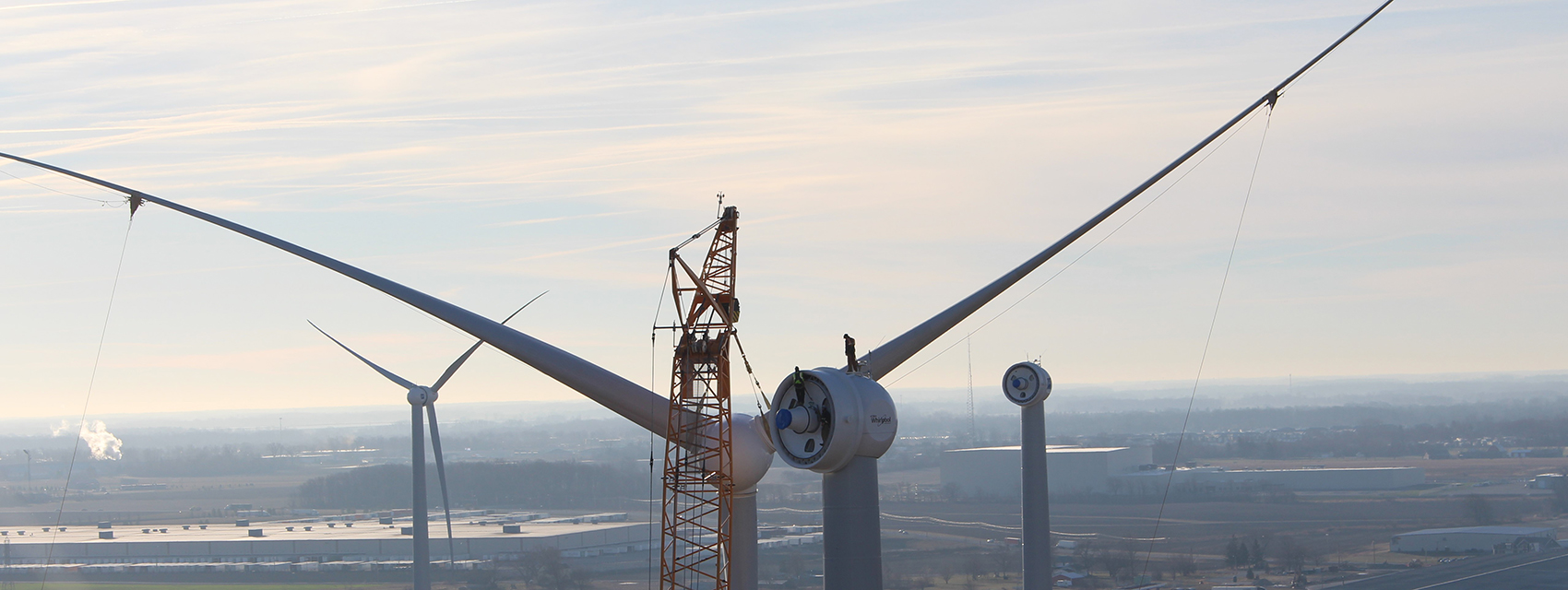
Rotor Fly
One Energy technicians attaching the blades and hub, or rotor, to a wind turbine generator.
Communities enjoy knowing one of their local industrial companies and major employers is making a 20-year commitment to the area.
Project Delivery:
The project delivery stage is made up of four concurrent activities: permitting, public rollout, procurement, and construction. This stage begins once the contract is signed.
During the delivery stage, One Energy works with the customer’s plant and corporate teams to decide how to announce the project to the public.
We believe wind projects benefit companies as well as their communities. Public rollout is important to One Energy because we believe we have a duty to be transparent with the communities we operate in. When we roll out a project, we want to get information out quickly and completely.
The project delivery stage is made up of four concurrent activities: permitting, public rollout, procurement, and construction.
To begin public rollout, we typically hold a stakeholder meeting with all key government officials in the same room, at the same time. In this meeting we present the project to stakeholders for the first time. The presentation includes sharing feasibility studies, answering questions, and addressing any concerns from all parties. This meeting can take 1-4 hours depending on the project and the community.
Following the stakeholder meeting, we aim to publish a press release about the project within 48 hours. The sooner we’re able to share the news, the better we can prevent misinformation. In general, the response to Wind for Industry is tremendously positive. We find that communities enjoy knowing one of their local industrial companies and major employers is making a 20-year commitment to the area.
After the project is public, One Energy immediately completes any remaining permitting that could not be finalized previously. This often includes zoning variances. (The Initial Evaluation and Detailed Evaluation explain the specific permitting requirements for each project.)
One Energy typically leads permitting activities and the public rollout. We will keep your team involved every step of the way, but the responsibility will be ours. As our customer, you can decide how involved you want to be.
As a project is being rolled out, One Energy is also making sure turbines are available for the project. If we have the turbines in our on-site inventory, then this step is easy. If we need to order new turbines for your project, then the lead time is between 6 – 9 months. All the permitting and international logistics are our problem.
After we have all the permits we need and the project is public, we can begin construction. Our construction team has the extensive experience and training required to complete a Wind for Industry project independently. One Energy self-performs almost all construction activities for Wind for Industry projects – because we’ve found the best way to deliver on the safety and quality our customers demand is to do the work ourselves.
One Energy extensively trains and equips our construction and operation teams.
Required Training:
OSHA 30-Hour Construction
Qualified Electrical Workers
First Aid/CPR
Task- and Equipment-Specific Training
Additional Training:
MSHA Part 46 Surface Miners
Emergency Medical Technician (EMT)
Advanced Emergency Medical Technician (AEMT)
Competent Tower Rescue
Tower Rescue Instructors
We are proud of the feedback we’ve received about our safe and considerate construction crew. One Energy team members will be a pleasure to have on your site. We have never had a lost time injury.
As One Energy builds new access roads, foundations, electrical systems, and of course, wind turbines, we are happy to show your team every step of the construction process. Events like “team member days” allow our customers’ employees to visit the site and see how cool Wind for Industry projects are up close.
We have never had a lost time injury.
As a One Energy customer, you do not need to be involved in day-to-day construction activities. One Energy will get the job done, and we will keep you informed along the way. We have developed proprietary software to track our quality program and documentation retention, and you’ll receive updates through our customer portal and regular reports. Curious about our progress? You are welcome to see the site any time.
The only thing One Energy needs from our customers during construction is coordination for the electrical tie-in of the project with your plant. One shutdown will usually be required for connection and, if we can, we will match your existing scheduled shutdowns.
As a vertically integrated company, One Energy controls the design, engineering, and construction of Wind for Industry projects. If a mistake is made, it is our responsibility to fix. In the history of our company, One Energy has never had an owner Change Order on any of our projects.
Construction takes 3-6 months depending on the complexity of your project. The project delivery phase ends when the turbines are operating.
Project Operation:
Once the project is operating, One Energy continues to monitor and take care of it.
We are responsible for the operation of the turbines and the project over its entire life. In REA projects we cover all the operational costs. In CAPEX projects, the customer is responsible for operational costs and service fees.
In general, we prefer to have the original equipment manufacturer (OEM) of the turbines perform service; this service is often included in the warranty agreement for the turbines. Turbine warranties range from 5 to 20 years.
One Energy performs all balance-of-plant maintenance and service, acts as the system operators for the project, and responds to all grid and plant issues. Our 24/7 service team is always only one call away.
In addition, we produce monthly operating reports for the project and share them with our customers. Check in on your Wind for Industry project using our customer portal, and rest assured it’s in good hands.
One Energy performs all balance-of-plant maintenance and service, acts as the system operators for the project, and responds to all grid and plant issues.
Our 24/7 service team is always only one call away.


